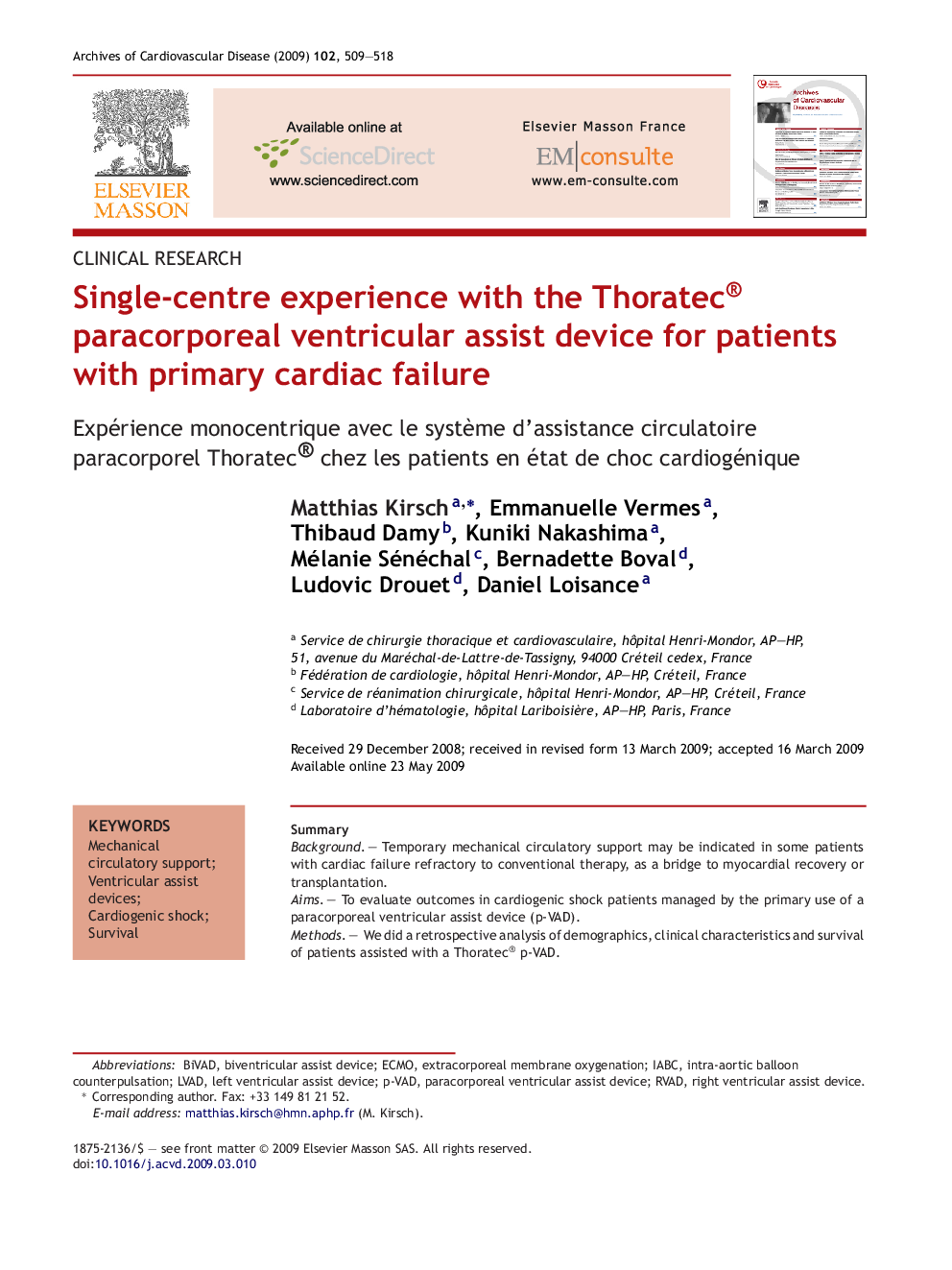| کد مقاله | کد نشریه | سال انتشار | مقاله انگلیسی | نسخه تمام متن |
|---|---|---|---|---|
| 2889529 | 1574402 | 2009 | 10 صفحه PDF | دانلود رایگان |

SummaryBackgroundTemporary mechanical circulatory support may be indicated in some patients with cardiac failure refractory to conventional therapy, as a bridge to myocardial recovery or transplantation.AimsTo evaluate outcomes in cardiogenic shock patients managed by the primary use of a paracorporeal ventricular assist device (p-VAD).MethodsWe did a retrospective analysis of demographics, clinical characteristics and survival of patients assisted with a Thoratec® p-VAD.Resultsp-VADs were used in 84 patients with cardiogenic shock secondary to acute myocardial infarction (35%), idiopathic (31%) or ischaemic (12%) cardiomyopathy, myocarditis or other causes (23%). Before implantation, 23% had cardiac arrest, 38% were on a ventilator and 31% were on an intra-aortic balloon pump. Cardiac index was 1.6 ± 0.5 L/min/m2 and total bilirubin levels were 39 ± 59 μmol/L. During support, 29 patients (35%) died in the intensive care unit and seven (10%) died after leaving. Forty-seven patients (56%) were weaned or transplanted, with one still under support. Despite significantly more advanced preoperative end-organ dysfunction, survival rates were similar in patients with biventricular devices (74%) and those undergoing isolated left ventricular support (24%) (63% versus 45%, respectively; p = 0.2). Actuarial survival estimates after transplantation were 78.7 ± 6.3%, 73.4 ± 6.9% and 62.6 ± 8.3% at 1, 3 and 5 years, respectively.ConclusionsOur experience validates the use of p-VAD as a primary device to support patients with cardiogenic shock. In contrast to short-term devices, p-VADs provide immediate ventricular unloading and pulsatile perfusion in a single procedure. Biventricular support should be used liberally in patients with end-organ dysfunction.
RésuméContexteL’assistance mécanique de la circulation peut être indiquée chez certains patients en choc cardiogénique en attente de recupération ou de transplantation. Nous rapportons notre expérience avec le système pneumatique paracorporel Thoratec® pour assister les patients en état de choc cardiogénique primaire.RésultatsQuatre-vingt quatre patients ont été assistés pour un état de choc lié à : un infarctus du myocarde (35 %), une cardiomyopathie dilatée idiopathique (31 %) ou ischémique (12 %), ou d’autres causes. Avant l’assistance, 23 % des patients ont subit un arrêt cardiaque, 38 % étaient sous ventilation artificielle et 31 % étaient assistés par un ballon de contre-pulsion intra-aortique. L’index cardiaque a été de 1,6 ± 0,5 L/min/m2 et la bilirubinémie totale de 39 ± 59 μmol/L. Après l’assistance, 29 patients (35 %) sont décédés pendant leur séjour initial en réanimation et sept (10 %) sont décédés après leur sortie de réanimation. Quarante-sept patients (56 %) ont été sevrés ou transplantés. Malgré une altération significativement plus importante de la fonction rénale et hépatique préopératoire, la survie des patients sous assistance biventriculaire (74 %) a été similaire à celle des patients sous assistance ventriculaire gauche isolée (respectivement, 39/62 [63 %] vs 9/20 [45 %], p = 0,2). La probabilité de survie après transplantation a été de 78,7 % ± 6,3, 73,4 % ± 6,9 et 62,6 % ± 8,3 à un, trois et cinq ans, respectivement.ConclusionsL’assistance circulatoire par le système pneumatique paracorporel Thoratec® donne des taux de survie acceptables chez les patients en état de choc cardiogénique primaire. Contrairement aux systèmes percutanés, ce système assure une perfusion pulsée avec une décharge optimale des cavités cardiaques défaillantes et autorise la réhabilitation des patients. Le recours à une assistance biventriculaire doit être libéral en cas de défaillance d’organes périphériques.
Journal: Archives of Cardiovascular Diseases - Volume 102, Issues 6–7, June–July 2009, Pages 509–518